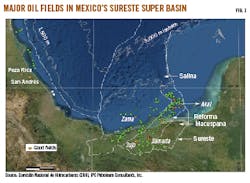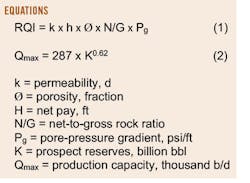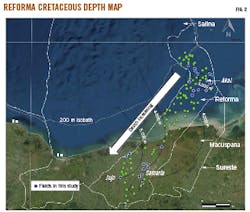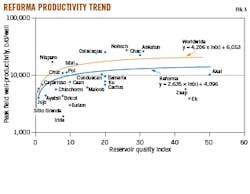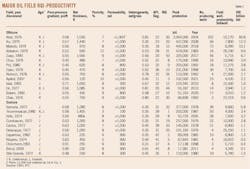Mexico’s Reforma sub-basin fields show high reservoir quality
Rafael Sandrea
IPC Petroleum Consultants Inc.
Tulsa, Okla.
Athenea Castillo
National University of Mexico
Mexico City, Mexico
Comparison of a reservoir-quality index (RQI) devised for carbonate fields in Mexico’s Reforma sub-basin with that of 34 of the world’s most productive oil fields showed that select Reforma sub-basin carbonate field productivity approaches the best of clastic-sandstone reservoirs.
Field well-productivity, defined as the ratio of a field’s production to the corresponding number of producing wells, is a key element in determining field or prospect economic feasibility. It also reliably translates prospect estimated ultimate recovery (EUR) reserves into production potential or maximum production capacity.
Field well-productivity simplifies decline behavior for both conventional and unconventional fields compared with well or field level production data (OGJ, Nov. 2, 2014, p 66). Field well-productivity’s translation of prospect EUR reserves is the determining factor in assessing a prospect’s future development drilling and production infrastructure requirements. The importance of this is heightened in the case of deepwater discoveries for which risks and rewards place a premium on making accurate estimates to support investment decisions.
Sandrea and Goddard developed a RQI from established reservoir parameters for 34 of the world’s most productive oil fields (OGJ, Dec. 5, 2016, p 22). Reservoir data and RQI determinations for the fields cover multiple depositional environments, a broad range of geologic ages, 28 clastic-sandstone reservoirs, six carbonate reservoirs plus four shale, and two oil sand fields in onshore and offshore settings from 16 countries. They also showed a solid mathematical relationship between RQI and peak field well-productivity. The algorithm is weighted towards clastic reservoirs, but it provides a foundation to generate reliable peak well-productivities for a broad range of conventional reservoirs.
Carbonate reservoirs, accounting for more than 60% of the world’s oil reserves, typically have lower porosity and permeability, and therefore lower RQIs and lower average well-productivities, than their clastic counterparts. Surprisingly, though, the six best carbonate field examples including Ghawar in Saudi Arabia and Cantarell in Mexico fit the clastic field algorithm. But this limited sample did not confirm that the worldwide algorithm would apply across a broad spectrum of carbonates. The objective of the study underlying this article was two-fold: to validate the RQI-field well-productivity model established in the 2016 study and, if appropriate, to create a base-case analysis for carbonate fields.
Reforma sub-basin
This analysis focuses on carbonate oil fields in Mexico’s Reforma sub-basin. This sub-basin, in the southern edge of Mexico’s Sureste super basin, is a smoking pipe-shaped area, 375 km long x 60 km wide (Fig. 1). Giant fields with greater than 500 million bbl EUR are in orange. The Reforma sub-province is flanked to the southeast by the Macuspana sub-province and to the northwest by the mostly offshore Salina del Istmo sub-province. It hosts more than 80% of all oil reserves discovered to date in Mexico (54 billion bbl) as well as 16 of the country’s 19 giant oil fields, among them the Cantarell field complex led by the supergiant Akal field.
The sub-basin offers a unique opportunity to analyze the distribution of field well productivity among its 180-plus oil fields which share a relatively consistent geologic environment and similar operational practices. Specifically, sample fields used in this study are all Cretaceous and Jurassic carbonates sharing a common sub-basin that stretches continuously from onshore to offshore. Pemex has been the sole operator. Reforma is a relatively small sub-basin but it hosts 16 giant oil fields, 10 of which are offshore at the shallow northeastern end of the sub-basin in the Cantarell complex.1-2 Six more giants are at the deeper onshore southwestern extreme, led by Samaria field.
This article analyzes peak field well-productivity and RQI across 25 major oil fields in the Reforma sub-basin. RQI is the product of five well-established reservoir characteristics: permeability (k), porosity (Ø), net pay (h), rock net-to-gross ratio heterogeneity (N/G), and pore-pressure gradient (Pg) (Equation 1).
Permeabilities in carbonates can be greater than 1 darcy (d) but are limited to 1 d in Equation 1 to keep RQI generally below 100 and maintain a manageable number for an index. When this index was originally defined, a sensitivity analysis was conducted to establish the validity of the set of five parameters pooled into the RQI. This analysis consisted of progressively peeling away different groups of parameters such as k x h and k x h x Ø, and so on. The results were definitive in that the complete set of five parameters generates the best correlation coefficient. These reservoir characteristics typically can be derived from cores, well logs, and well tests captured from discovery wells.
Table 1 summarizes data for 25 major oil fields – 14 offshore and 11 onshore - selected for this study. The data include the five reservoir parameters discussed above and six key field attributes: age, API oil gravity, peak oil production, year of occurrence, number of producing wells at peak, oil in place (OIP), and well-productivity index. Fig. 2 shows locations of the fields. The map contains contour plots showing depths (rotary-table referenced) to the top of the common Cretaceous (K) reservoir. Reservoir depths dip steadily, from 1,690 m at the supergiant Akal offshore field in the northeast to 5,115 m at the onshore Jujo-Tecominoacan giant field in the southwest corner of the sub-province.
Peak productivity, maximum capacity
Table 1 shows that the two main reservoirs in Reforma consist of massive dolomites and limestones of Cretaceous (K) and Jurassic (J) age. These are characterized by a natural network of highly interconnected fractures with good porosities (for carbonates) of around 8% and extremely high permeabilities in the darcy-range, both of which favor high peak field well-productivities of 3,000-27,000 b/d/well. There are several theories regarding the cause of these high carbonate permeabilities. One connects them to the Chicxulub event, a high energy asteroid impact that occurred in the nearby Yucatan Peninsula, marking the Cretaceous-Paleogene boundary.
Reforma’s reservoirs are overpressured, as evidenced by pore pressure gradients well above the 0.45 psi/ft norm. High reservoir pressures likewise favor high well-productivities. Fields favored with sizable net thicknesses, 500 ft and greater, are also associated with top quality reservoirs and larger RQI. Calculated RQI for 25 Reforma oil fields varies from 1 to 50, with the highest at the prolific Akal field in the Cantarell complex.
Fig. 3 is a cross-plot of peak field well-productivity and RQI for fields analyzed in this study. It underlines two significant observations:
- Offshore and onshore fields have melded reservoir characteristics.
- Fields with RQI > 20, independent of size, are offshore.
Fig. 3 also shows two trendlines, one (blue) is for fields in this study and the other (orange) is from the Sandrea and Goddard 2016 correlation. The latter worldwide upper trendline largely corresponds to clastic-sandstone reservoirs, encompassing a broad spectrum of 20 different petroleum systems and a 50-50 mix of disassociated onshore and offshore fields.
The Reforma trendline represents 25 carbonate fields in a single petroleum system with a mix of related onshore and offshore fields. Sandstone reservoirs have on average 35% higher RQI than carbonates reservoirs, but some of the Reforma reservoirs match or exceed the worldwide trend line.
As an example of the importance of RQI well productivity correlations, assume a discovery well has just been drilled in a new prospect. This first well provides a wealth of core petrophysical information and the opportunity to conduct drill stem production tests (DST). Management wants an early estimate of development costs. Core and petrophysical analyses provide an RQI value. This in turn provides, from the correlations in Fig. 3, an assessment of peak field well-productivity in expected b/d/well.
The discovery is drilled based on an estimation of the prospect’s potential reserves. Equation 2 relates the prospect’s reserves to its production capacity. For expected reserves of 100 million bbl, the production potential of the field would be 70,000 b/d. Assuming the prospect’s RQI is 10 based on core and petrophysical data, the corresponding peak well-productivity for a carbonate reservoir would be 10,000 b/d/well, and the prospect would need seven producing wells. This analysis thus provides basic field elements for subsequent financial analysis: the number of wells and production capacity for the new field.
Reforma has provided essentially lab-scale validation of RQI not only as a robust measure of sophisticated reservoir characteristics but also as an appropriate correlation companion to peak field well-productivities. For future applications, the upper worldwide curve would be appropriate to use for clastic-sandstone reservoirs and the lower Reforma curve would be appropriate to use for carbonate reservoirs.
References
- Provincia Petrolera Sureste, Pemex, 2013. https://docplayer.es/12714590-Provincia-petrolera-sureste-salina-del-istmo-reforma-akal-y-macuspana.html.
- Ortega, J., “Interpretation and Validation of a 3D Structural Model of a Portion of the Pilar Reforma-Akal,” Geological Engineering Degree Project Report, Instituto Politecnico Nacional, Mexico, June 2, 2016.
The authors
Rafael Sandrea ([email protected]) is president of IPC Petroleum Consultants, Inc., based in Tulsa. He holds a PhD (1967) in petroleum engineering from Penn State and is a life member of SPE, member of the UN ad hoc Group of Experts on Fossil Resources, Geneva, and a distinguished fellow at EPRINC. He has published over 40 technical papers covering areas such as risk analysis for international upstream investments, appraisal of conventional and unconventional oil & gas reserves, and EOR potential.
Athenea Castillo ([email protected]) is a PhD candidate at the National University of Mexico (UNAM), Mexico City, Mexico. She holds a BS (2020) in geological engineering from the National Polytechnic Institute of Mexico and has served as a research assistant to IPC Petroleum Consultants, Inc.
